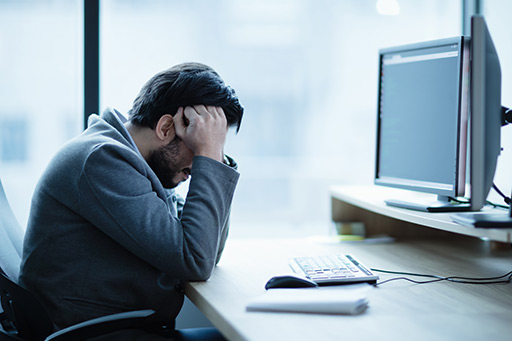Tension Headache From Stress [How To Deal With It]

What Is A Tension Headache?
A tension headache has specific characteristics manifested in the individual. It feels like an elastic band around the head that is squeezing the head tightly all around. The pain is like a dull ache with tightness around the head.
How Surrounding Muscles Feel
These headaches are triggered when the muscles around the scalp, neck, and shoulders become tense. These muscles can feel tender and sensitive to the touch. The pain can also occur when these muscles contract. The contraction can result when the patient sustains an injury to the head, feeling anxious or depressed, or when, most commonly, he experiences stress.
Episodic Versus Chronic Tension Headaches
Episodic tension headaches usually last for a finite period, then stop. The duration can be as short as a half-hour. Chronic tension headaches can last for hours to weeks at a time. Episodic headaches can turn into chronic headaches if the duration is prolonged and occur very frequently in a month.
Activities That Cause Tension Headaches
Since these headaches stem from how the muscles around the scalp, neck, and shoulders react, activities that place significant demands on these groups of muscles will likely result in a tension headache from stress.
Any activity requiring the head to remain stationary for a long time can result in a headache. An everyday activity can be typing on the keyboard or other kinds of work in front of the computer. The head seldom moves when the individual is staring at the computer screen. The person can be so engrossed in work that he does not realize that his head has not moved for a long time until he feels a headache.
Doing work that involves accuracy or fine motor movements can also cause the head to remain stationary. Jewelry making, needlework by hand, or working with a microscope requires the individual to focus on the work at hand intensely—the eye muscles strain, which affects the facial muscles connected to the head and neck.
During sleep, if the head and neck are not supported properly, it can place stress on the neck and shoulder muscles. Also, if the room is cold, the muscles can contract and cause a tension headache.
Activities that require the body to overexert will trigger tension headaches. When the body remains in an exhausted and tired state, headaches will ensue.
Emotional Stress
It is undisputed that the body and mind are strongly interconnected. When the mind experiences emotional stress, it can have a tremendous impact on the physical body. Emotional stress occurs when the individual experiences an unpleasant or traumatic event.
These can happen anywhere. A person can get laid off from the job and start to worry that he will not be able to provide for his family financially. A loved one can be bedridden with an illness. Dealing with family members with whom a person cannot get along creates a stressful environment at home. Putting up with an irritating neighbor or random rude individuals in a store can trigger emotional stress and result in a headache.
Feeling overwhelmed with life’s many demands can bring on chronic tension headaches because these demands occur daily. When an individual feels like there is no way out, he can succumb to feeling depressed and anxious. These are sure ways to bring on tension headaches.
Ways to Manage Stress
A lot of energy can be spent reacting to the problem instead of figuring out how to target the root of the problem, causing tension headaches. A trained practitioner can advise the patient on what he can do in reducing the stressors in his life. He can teach techniques in responding to stressful situations, so the impact on the physical body is reduced.
Deep Breathing

One efficient and easy way to reduce stress on the spot is by deep breathing. When the body is stressed, the heart rate increases, and the breath becomes short. One way to counteract this response by the body is to practice deep breathing.
For those who have never practiced deep breathing before, the easiest way to start is belly breathing. The patient sits or lies down in a comfortable position. He places one hand on the belly and the other hand on his chest. He breathes deeply through his nose, allowing his stomach to push his hand forward. There should be no movement on the chest. Then, the patient opens his lips slightly as if to whistle and slowly breathes out through his lips. The hand on the belly gently depresses the abdomen as he exhales slowly.
Breathing is slow and mindfully from three to ten times. At the end of the set, the patient should feel more relaxed.
Breathe deeply any time the individual feels stress coming on. It takes less than a minute to breathe deeply three times. Instead of immediately reacting to a stressful situation with anxiety, the patient can slow down, take a minute, and breathe a few times deeply before responding.
Meditation
Another great way to calm the anxiety level is by meditating. Meditation helps the muscles release tension and gets the body to relax. It can fundamentally bring about changes to the body physiologically. When the body and mind are relaxed, serotonin is released, which helps the mind feel less anxious and better all-around emotionally. Blood pressure decreases, and the heart does not have to work as hard.
All that is needed is a quiet place where the individual can sit comfortably and relax. No special equipment or props are required. If there are noises in the environment that are distracting, soft instrumental music in the background can mask these undesirable noises.
Meditation incorporates the deep breathing technique described above. The client can visualize an image on which he can focus his attention. He can even concentrate on his breathing as he slowly and mindfully inhales and exhales.
Meditation is a fast and easy way to reduce stress. The practitioner can guide the client in meditation techniques during a therapy session. When the client learns how to do this properly, he can apply these techniques at home.
Regular Exercise
Exercising has multiple benefits, one of which is stress reduction. Exercising stimulates the production of endorphins in the brain. Endorphins are the neurotransmitters that improve a person’s mood as well as neutralize the pain.
Any aerobic activity can increase the production of endorphins. For a usually inactive person, he can start with a brisk walk of 30 minutes a day. As the body gets more accustomed to exercising, the brisk walk can change into a jog. Biking, hikes, dancing, and any activity that can get the heart pumping can be practical.
Exercising places demands on the body but in a good way. It can mimic the body’s flight or fight reaction that often results from harmful stress. However, since there is no actual threat in exercising, the body and mind will learn to work together through these natural reactions. As a result, it will teach the body to handle negative stress more effectively.
As the individual focuses on his body movements during his rhythmic walk or jog, he can clear his mind of things that cause him to worry and stress.
Before the client undergoes a new exercise regimen, he should get a complete physical exam to ensure no underlying conditions will negatively impact increased physical activity.
Changes in Lifestyle
In addition to exercising, the practitioner can help the client evaluate the areas in his life to make it less stressful.
If the client is stressed about running out of time, he can learn how to manage his time better. He can learn how to prepare a realistic list of things to do for the next day to improve time management and organization.
The practitioner can evaluate the client’s diet. If the client is always in a rush, there is a good chance that he usually grabs convenience foods to eat on the run and is not eating a healthy diet regularly. Healthy lifestyle changes help the client get better nutrition from their diet. The client will get more energy and feel less tired.
The client should make time to do enjoyable things. All work and no play will indeed have detrimental effects on anyone. He should make time to spend with friends and loved ones.
Evaluation By A Practitioner

Tension headaches are related to migraines, and if there is a family history of migraines, it can make a person more prone to tension headaches.
Excessive consumption of alcohol or caffeine can exacerbate headaches. An unhealthy diet and a sedentary lifestyle can also make headaches worse.
How BioScan Can Help
Since stress is the most common trigger, you can use the BioScanSRT system to determine potential substances that are stressing the body. The system reports how the body responds to various stressors. Scan results outside of these parameters can identify possible substances that are causing the stress.
You can use multiple methods and tools to re-balance the energy flowing through the patient’s meridians and re-calibrate how the body responds to the stressors. The response is recorded and measured through biofeedback machine so you can monitor the effectiveness.
Tension headaches can be severe enough to reduce a patient’s quality of life significantly. Chronic headaches can be debilitating to the point where your patient cannot be productive at work or home. You can design a protocol for the patient to reduce or eliminate the stressors that are impairing them.
Both the BioScan SRT and BioScan MSA systems can help you make decisions on how to deal with patient’s stressors so they can enjoy a healthy and happy life.
